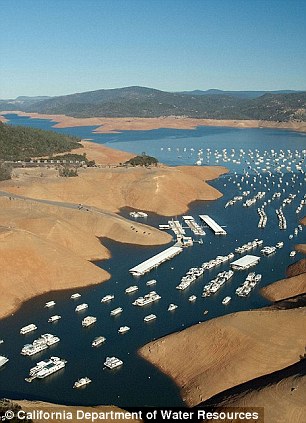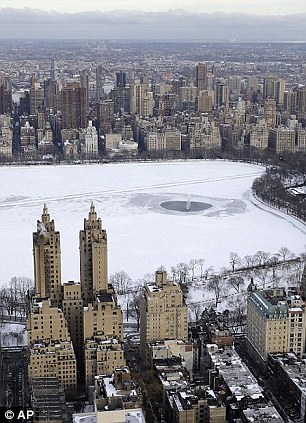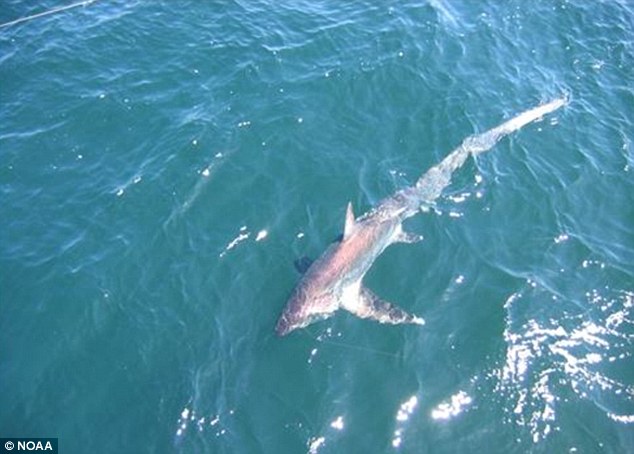http://www.cbc.ca/news/canada/briti...-in-pacific-ocean-could-hurt-salmon-1.3001677
'Warm blob' of water in Pacific Ocean could hurt salmon
Scientist Dick Beamish says it could take years to know the full impact of warm blob on fish
By The Early Edition, CBC News Posted: Mar 19, 2015 11:47 AM PT| Last Updated: Mar 19, 2015 11:55 AM PT
Spawning sockeye salmon are seen making their way up the Adams River in Roderick Haig-Brown Provincial Park near Chase, B.C. in 2014. Scientist Dick Beamish worries salmon could feel the impact of a warm blob of water travelling south down the Pacific Coast. (Jonathan Hayward/The Canadian Press)
Warm waters could hurt B.C. marine life 6:22 http://www.cbc.ca/news/warm-waters-could-hurt-b-c-marine-life-1.3001434
Related Stories
■Chinook salmon could be wiped out by 2100, new study claims
■Sea life relocating fast in response to climate change
■Last decade warmest on record, says UN report
A "warm blob" of water — which originated in the Gulf of Alaska — is moving south along the Pacific Coast, and scientists are warning it could hurt marine life in B.C.
"Probably I think is fair to say it's unprecedented in terms of the oceanography," Dick Beamish, a retired scientist with Fisheries and Oceans Canada, told The Early Edition's Rick Cluff.
The blob is up to 3 C warmer than average temperatures, which Beamish said will be a significant increase to fish like salmon.
"It sure makes a difference to animals that don't regulate their body temperature, so this is major event."
■Chinook salmon could be wiped out by 2100, new study claims http://www.cbc.ca/news/technology/c...-wiped-out-by-2100-new-study-claims-1.2881635
■Sea life relocating fast in response to climate change http://www.cbc.ca/news/technology/sea-life-relocating-fast-in-response-to-climate-change-1.1362068
■Last decade warmest on record, says UN report http://www.cbc.ca/news/canada/manitoba/last-decade-warmest-on-record-says-un-report-1.1330948
Beamish said there is no question it will have an impact on marine life, but said it will take a long time to know the full impact.
"The effect is through the food chain, and so because it's through the food chain, most likely you would see that through juvenile fish survival and then you don't see the consequences of the changes in juvenile survival for a few years," he said.
"It's not so much that you're going to see something instantly. We are seeing, according to the report, mortality of birds and certainly some effect on marine mammals, but in terms of fish — let's say particularly salmon — it's not so easy to forecast what is going to happen."
To hear the full interview with Dick Beamish, click the audio labelled: Warm waters could hurt B.C. marine life.
'Warm blob' of water in Pacific Ocean could hurt salmon
Scientist Dick Beamish says it could take years to know the full impact of warm blob on fish
By The Early Edition, CBC News Posted: Mar 19, 2015 11:47 AM PT| Last Updated: Mar 19, 2015 11:55 AM PT
Spawning sockeye salmon are seen making their way up the Adams River in Roderick Haig-Brown Provincial Park near Chase, B.C. in 2014. Scientist Dick Beamish worries salmon could feel the impact of a warm blob of water travelling south down the Pacific Coast. (Jonathan Hayward/The Canadian Press)
Warm waters could hurt B.C. marine life 6:22 http://www.cbc.ca/news/warm-waters-could-hurt-b-c-marine-life-1.3001434
Related Stories
■Chinook salmon could be wiped out by 2100, new study claims
■Sea life relocating fast in response to climate change
■Last decade warmest on record, says UN report
A "warm blob" of water — which originated in the Gulf of Alaska — is moving south along the Pacific Coast, and scientists are warning it could hurt marine life in B.C.
"Probably I think is fair to say it's unprecedented in terms of the oceanography," Dick Beamish, a retired scientist with Fisheries and Oceans Canada, told The Early Edition's Rick Cluff.
The blob is up to 3 C warmer than average temperatures, which Beamish said will be a significant increase to fish like salmon.
"It sure makes a difference to animals that don't regulate their body temperature, so this is major event."
■Chinook salmon could be wiped out by 2100, new study claims http://www.cbc.ca/news/technology/c...-wiped-out-by-2100-new-study-claims-1.2881635
■Sea life relocating fast in response to climate change http://www.cbc.ca/news/technology/sea-life-relocating-fast-in-response-to-climate-change-1.1362068
■Last decade warmest on record, says UN report http://www.cbc.ca/news/canada/manitoba/last-decade-warmest-on-record-says-un-report-1.1330948
Beamish said there is no question it will have an impact on marine life, but said it will take a long time to know the full impact.
"The effect is through the food chain, and so because it's through the food chain, most likely you would see that through juvenile fish survival and then you don't see the consequences of the changes in juvenile survival for a few years," he said.
"It's not so much that you're going to see something instantly. We are seeing, according to the report, mortality of birds and certainly some effect on marine mammals, but in terms of fish — let's say particularly salmon — it's not so easy to forecast what is going to happen."
To hear the full interview with Dick Beamish, click the audio labelled: Warm waters could hurt B.C. marine life.







